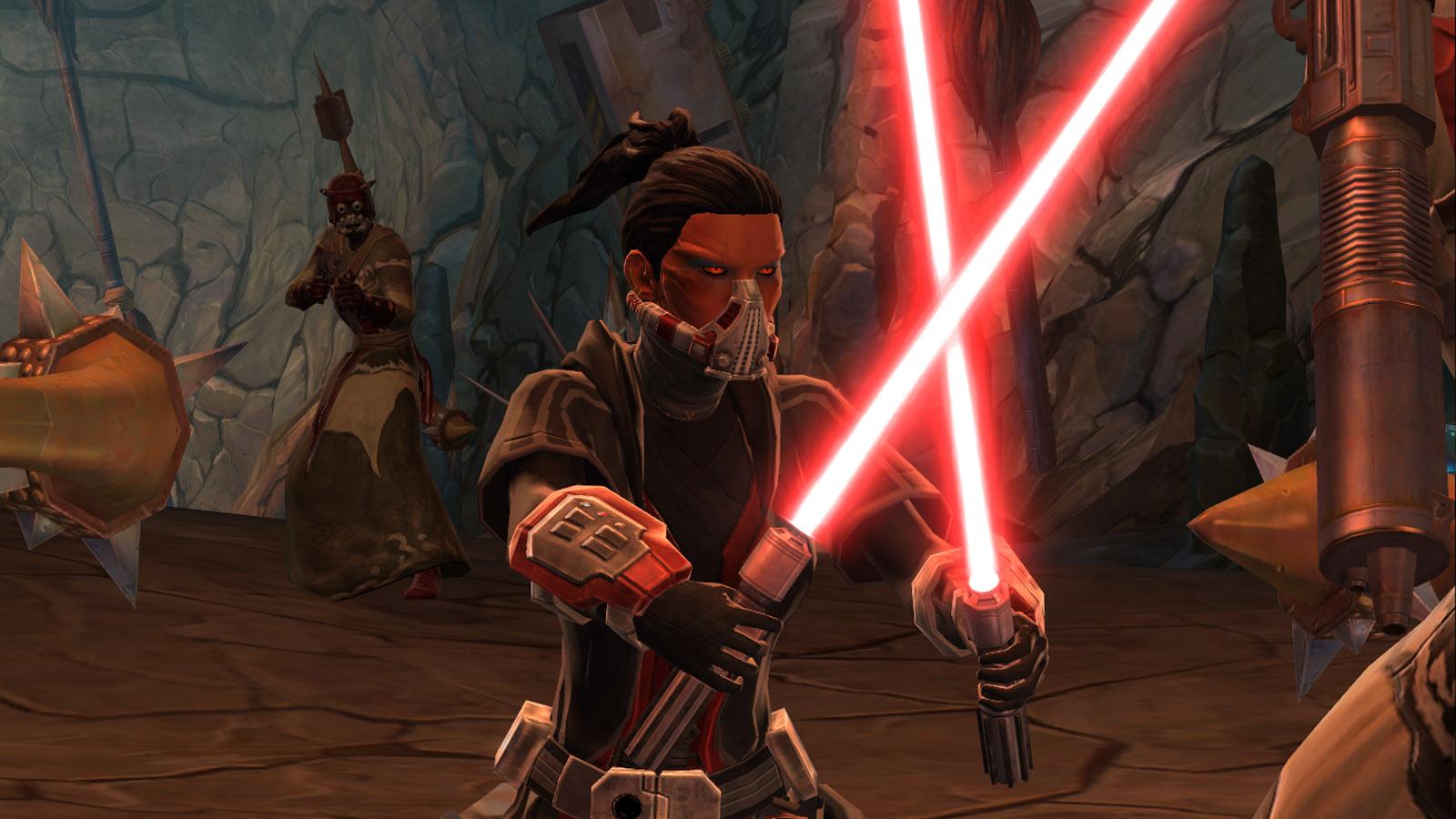Why you can trust GamesRadar+
Put your crew to work
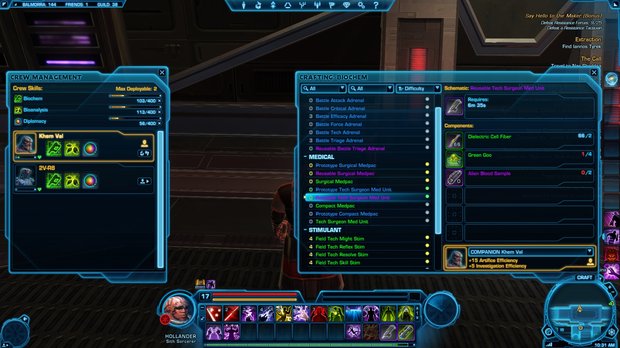
Above: We let them do the work while we have the fun
Crafting and gathering are found in almost every major MMO, and The Old Republic is no different, but BioWare put a unique spin on the formula in a few interesting ways that make for a much better integrated experience. Players can learn three “Crew Skills,” which level up like traditional crafting and gathering skills, and send their Companions to do the work for them. Instead of slaving over a hot crafting table for hours, we sent our companions on missions to gather different types of materials and craft gear. Sure, you lose the experience of watching a bar go up and standing in one place, but you gain the ability to craft while doing other things, and that’s a swap we’re willing to make.
Crew skills aren’t the only wrench BioWare threw into the works. Also added is the ability to “Reverse Engineer” crafted goods – an act which breaks down the crafted item to regain some of the material components. This isn’t an original idea in and of itself, but it lends itself to a bigger, unique aspect of crafting: discoverable schematics. Reverse engineering an item has the chance to unveil a better version of that item, and reverse engineering that can yield an even better version – and there are a multiple upgraded versions of each.
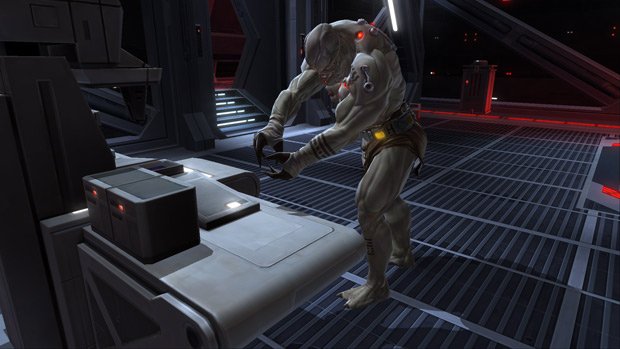
Above: When Companions are at work they literally go to the crafting table on your ship
It’s costly, and success isn’t guaranteed (sometimes we reverse engineered an item dozens of times to no avail, other times we were rewarded with a new schematic almost immediately), but it made it possible to create truly enhanced gear with the perfect stats for our class.
Another fold added to The Old Republic’s items comes in the form of Prototype gear. With these items, all of the stats come from the Item Modifications it’s made up of, letting us upgrade the items we had with better Modifications, or rip out the Modifications from our old gear to put into our new ones. In World of Warcraft, we’d enhance our gear with gems.
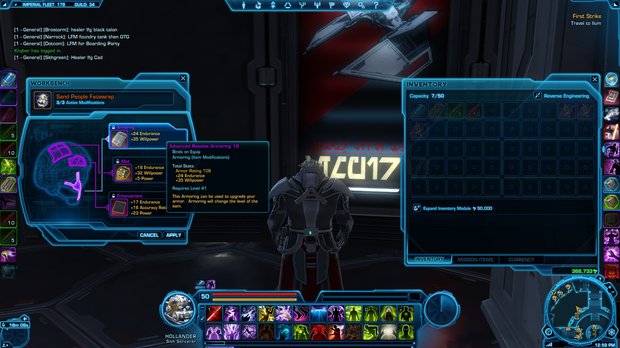
Above: Prototype gear also allows you to make cosmetic choices
In The Old Republic, some of your items are literally only as good as the Modifications they’re made up of. Different items accept different types of Modifications, and they can be ripped out and swapped between items for a price. It’s a brilliant system, and makes upgrading gear steadily possible, instead of just outright swapping items every few levels. It also means finding an item we couldn’t use didn’t mean we were forced to sell it – if the Modifications still worked for us we could remove them and add them to items we could use.
The Great Galactic War
One area where BioWare made very little attempt to innovate is in the PvP combat, which is essentially copied straight from the modern MMO formula. They do some things better, some things worse, and some things differently, though we’d certainly love to see them expand it to fit more in line with the rest of the game. At launch there were three Warzones available.
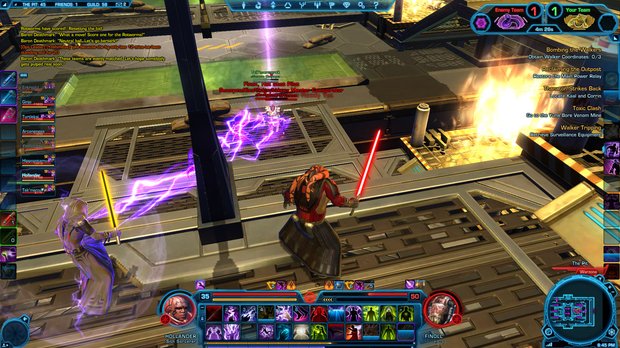
Above: The only rule of Huttball? No kicking, because "Hutts don't have feet"
There’s a fairly typical assault mode, where one team defends a series of doors while the other tries to plant bombs on them; a capture-point mode on Alderaan, where points activate turrets that fire on enemy ships; and Huttball, a more unique mode where mixed-faction teams attempt to carry a ball over a goal line.
Winning in PvP rewarded us with Commendations we could use to get better PvP-specific gear – just as it does in every other MMO on the market. None of the Warzones are exceptionally strong (though we’d be lying it we didn’t admit our guilty pleasure for Huttball), and it feels like they all need some work when it comes to balancing, but they’re all a good deal of fun if you’re in a good group. If you’re not, you’re going to have to deal with the typical issues of players not understanding the rules, being matched against pre-made groups, and the occasional problem in Huttball where the mixed-teams will result in teammates helping the opposing team because their guild is represented in it. It’s all stuff that should be worked out soon, but the foundation is definitely there for success.
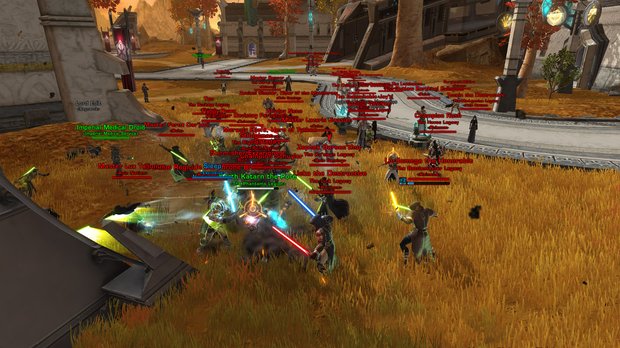
Above: Griefing and spawn-camping isn't fun for anyone
Open-world PvP is also available in a number of different areas, but at launch there's nothing organized going on. Instead, it's mostly filled with roving groups of gankers - griefing players taking advantage of the fact that, for some reason, NPCs won't defend their faction. Even though there are high-level guards wandering around the faction cities on end-game planets, they just sort of stand around while their cities are invaded. It's either a bug or bad design - either way it's annoying, and something BioWare should attempt to fix. Hopefully, by fleshing out the level 50 PvP planet of Ilum more, it will help give players incentive to move their PvP there, so lower-level players don't get spawn camped on PvP servers.
After the credits roll
Every plotline’s conclusion is left open to support future extensions of the story quests, but, alas, the story itself eventually ends. After 150 or so hours we hit the level cap and started looking to the end game for content. What we found wasn’t all that surprising, though it was a bit disappointing: besides being able to better compete in player-versus-player combat, we found a number of hard-mode versions of the same Flashpoints we had already completed on our quest to 50 and a few eight and 16-person raids.
Above: This is the first part of the game's first Flashpoint; check out the rest here
SWTOR’s Flashpoints are the game’s instanced dungeons. They tend to seesaw between being fantastic, story-driven adventures, or plotless and utterly dull. Going back and completing them on harder difficulties rewards players with tokens they can use to buy better gear to complete harder Flashpoints which reward different currencies which are used to buy better gear used to complete harder Flashpoints. It’s a grind – a treadmill – and it doesn’t take advantage of any of the game’s unique elements. We were disappointed that BioWare didn’t do more with the end-game, as it's another area of the genre in dire need of innovation instead of repetition. As far as generic end-game instances go, however, SWTOR’s are about on par with every other game’s.
One area of the end-game we weren’t able to test much was the Legacy system because, well, it’s not entirely done. Around level 30 we unlocked the ability to create a unique last name that would be shared across our characters. At this point a Legacy bar appeared under our experience bar and we began to earn Legacy levels. Right now they do… nothing, actually. Going to the Legacy page reveals a “Future Legacy features coming soon” message. Creative director James Ohlen has commented that the Legacy system will be updated to “include being able to shape your Legacy’s family tree,” but beyond that all speculation is just that – speculation.
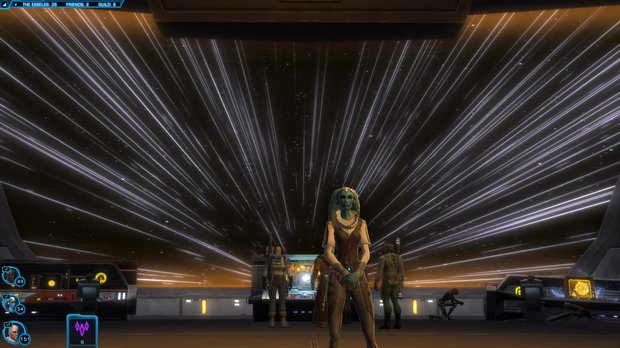
Above: Going so fast the stars turn into lines
Rumors are it might involve being able to unlock new customization options, being able to share experience between characters, or even unlocking new passive buffs or races to use in the character customization. While this sounds all well and good, we really wish it was available for launch, because all of the ambition in the world doesn’t change what the Legacy system is right now: a last name and a purple bar that doesn’t unlock anything. We’ll be keeping an eye out for news surrounding the Legacy system, though, as it seems like a genuinely interesting idea that plays right into SWTOR’s many, many strengths.
More info
| Genre | Role Playing |
| Description | Players will explore an age thousands of years before the rise of Darth Vader when war between the Old Republic and the Sith Empire divides the galaxy. Choose to play as Jedi, Sith, or a variety of other classic Star Wars roles and determine your path down the light or dark side of the Force. |
| Franchise name | Star Wars |
| UK franchise name | Star Wars |
| Platform | "PC" |
| US censor rating | "Teen" |
| UK censor rating | "" |
| Release date | 1 January 1970 (US), 1 January 1970 (UK) |
Hollander Cooper was the Lead Features Editor of GamesRadar+ between 2011 and 2014. After that lengthy stint managing GR's editorial calendar he moved behind the curtain and into the video game industry itself, working as social media manager for EA and as a communications lead at Riot Games. Hollander is currently stationed at Apple as an organic social lead for the App Store and Apple Arcade.
